Artist: Man Ray (1890-1976), dandy, dada, and the most formally creative photographer of the 20th century, who invented new methods such as the Rayograph and straddled the two worlds of the avant-garde and fashion photography from his vast bed equipped with special sliding worktables, where, he claimed, he spent most of his time in his apartment in Rue Férou, Paris.
Man Ray was an American in Paris, born Emmanuel Rudnitsky in Philadelphia. In 1917, he was one of the founders of New York Dada, the Manhattan branch of the international subversive movement that protested against the first world war by making wilfully broken, ironic, aggressively playful art. In New York and then from the 1920s in Paris, Man Ray was a relaxed collaborator, happy to pool his ideas with other artists and, above all, his friend and fellow dada Marcel Duchamp.
Subject: Rrose Sélavy first appeared in the annals of art in 1920 as Rose Sélavy, which sounds like: "Rose, c'est la vie." In 1921, she acquired the extra "r" when she added her signature to L'Oeil Cacodylate, a painting by Francis Picabia. But Rrose Sélavy - "eros, that's life" - is most often identified as the author of works by Marcel Duchamp (1887-1968). The pun that is Rrose Sélavy is an expression of everything Duchamp's art is about; eros, that's it, that's all there is.
Distinguishing features: In choosing Man Ray to take a portrait of Rrose Sélavy, Duchamp co-opted the most adept photographer of glamour on behalf of the 20th century's most celebrated conceptual art. Man Ray gives Rrose the lighting, the sultry look, that made him so in demand in magazines such as Vogue. In a series of photographs in 1921 and later in the mid-1920s, his camera searches for Rrose in Marcel Duchamp, and eventually finds her.
This is one of the early, deliberately harsher, cruder, more dada photographs, in which Man Ray allows us to see Duchamp's all too masculine features, the long chin, the big nose, the hawkish profile. This 1921 picture of Rrose in heavy velvet hat, with flowing hair and splendid collar was taken to find an image for the bottle of perfume that Duchamp labelled Beautiful Breath, Veil Water (1921). The frankness of this picture, the jutting presence of Duchamp inside his costume of old clothes, is as deliberate as the later pictures of Rrose in which she becomes more attractive, glimpsed in soft-focus lighting and stylish 1920s garb. Here the effect is much more charity shop and seedy, as if she were a secret transvestite photographed in a back street studio, dreaming of what she might be. It feels like a confession. But with Marcel Duchamp nothing is ever that simple.
Inspirations and Influences: Androgyny and gender deception have a deep history in the portrait, as Duchamp pointed out when he made the Mona Lisa a man. It has been argued, for example, that Sargent's notorious Madame X (Mme Pierre Gautreau), now in the Metropolitan Museum of Art, New York, which caused a scandal with its outrageous sexuality when exhibited in Paris in 1884, is a disguised portrait of a young man.
Where is it? In the show Surrealism: Desire Unbound at Tate Modern, London SE1 (020-7887 8008), until January 1, 2002.
